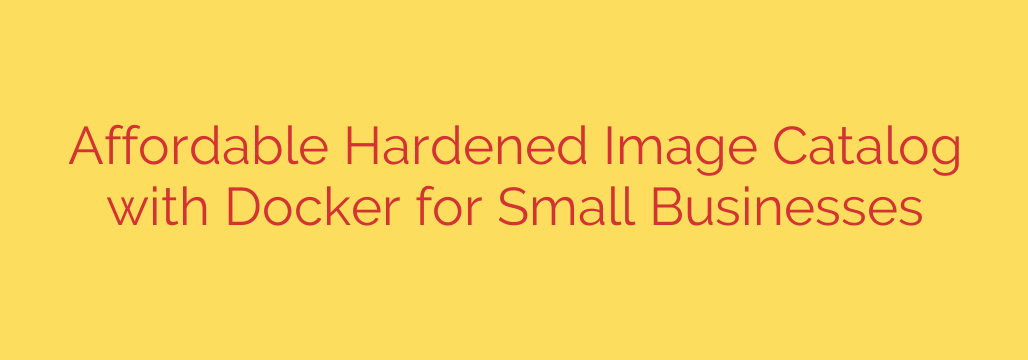
Secure Your Applications: Building a Hardened Docker Image Catalog on a Small Business Budget
For small and medium-sized businesses, Docker has revolutionized application development, making it faster and more efficient than ever. However, this speed can come with a hidden cost: security vulnerabilities. Relying on public, unvetted container images from repositories like Docker Hub can expose your business to significant risks.
The solution isn’t to abandon containers, but to take control of your software supply chain. Building a private, hardened image catalog is a critical step toward securing your applications—and it’s more achievable and affordable than you might think.
The Hidden Dangers of Public Docker Images
When you pull a public image, you’re inheriting its entire history, including its potential flaws. Many publicly available images contain known security vulnerabilities, outdated packages, or unnecessary tools that can become attack vectors.
The key risks include:
- Known Vulnerabilities: Public images can be built on base layers with unpatched vulnerabilities (CVEs) that hackers actively exploit.
- Embedded Malware or Secrets: Malicious actors have been known to upload compromised images containing cryptocurrency miners, backdoors, or exposed credentials.
- Software Bloat: Many images include unnecessary libraries, shells, and utilities. While convenient for debugging, these tools increase the potential attack surface of your production application.
- Lack of Control: When an upstream image changes without your knowledge, it can break your application or introduce new security holes unexpectedly.
What Exactly is a “Hardened” Docker Image?
A hardened Docker image is a container image that has been systematically secured to minimize its attack surface and strengthen its defenses. This isn’t a single action but a continuous process focused on several key principles.
The core components of a hardened image are:
- Minimal Base Images: Instead of using a full-blown operating system like Ubuntu, a hardened image starts with a minimal base, such as Google’s “distroless” images, Alpine Linux, or slim variants. These contain only the essential libraries and binaries your application needs to run, and nothing more.
- Regular Vulnerability Scanning: Hardened images are consistently scanned for known vulnerabilities using automated tools. This process should be integrated directly into your development and deployment pipeline.
- Secure Configurations: The image is built with security best practices in mind. This includes running processes as a non-root user, removing unnecessary permissions, and ensuring file systems are read-only where possible.
- Reduced Attack Surface: All non-essential software, such as package managers (apt, apk), shells (bash), and build tools (compilers, git), are removed from the final production image.
How to Build Your Affordable Hardened Image Catalog
Creating a secure catalog doesn’t require an enterprise-level budget. By leveraging modern tools and best practices, even a small team can build a robust and affordable system.
1. Choose Your Secure Base Image
The foundation of a secure container is its base image. Avoid generic, bloated images. Instead, start with a minimal, security-focused base. Distroless images are an excellent choice as they contain only your application and its runtime dependencies. If you need a shell or package manager for more complex setups, Alpine Linux is a lightweight and popular alternative.
2. Implement Multi-Stage Builds in Your Dockerfile
A multi-stage build is one of the most powerful features for creating lean, secure images. This technique allows you to use a larger, feature-rich image to compile your code and build your application, and then copy only the necessary artifacts into a clean, minimal production image.
This process ensures that no compilers, build tools, or development dependencies make it into your final container, dramatically reducing its size and attack surface.
3. Integrate Automated Vulnerability Scanning
You can’t secure what you can’t see. Integrate an open-source scanner into your CI/CD (Continuous Integration/Continuous Deployment) pipeline to automatically check your images for known vulnerabilities.
- Actionable Tip: Tools like Trivy and Grype are free, easy to use, and integrate seamlessly with platforms like GitHub Actions, GitLab CI, and Jenkins. Set up your pipeline to scan every new image and fail the build if high-severity vulnerabilities are detected.
4. Set Up a Private Container Registry
A private registry is the “catalog” where you store your trusted, hardened images. This becomes your company’s single source of truth for deployments, ensuring that developers are only using approved, scanned, and secure containers.
Affordable options for small businesses include:
- Docker Hub: Offers private repositories on its free and low-cost tiers.
- GitHub Container Registry (ghcr.io): Integrates directly with your GitHub repositories and offers generous free storage and bandwidth.
- DigitalOcean Container Registry: A cost-effective, managed solution for storing private images.
- Self-Hosted: For more control, you can host your own registry using open-source projects like Harbor or the official Docker Registry image.
5. Automate and Enforce Security Policies
The final step is to automate the entire process. Your CI/CD pipeline should be configured to:
- Build the application using a multi-stage Dockerfile.
- Scan the final image for vulnerabilities.
- If the scan passes, push the hardened image to your private registry.
- Deploy the application using only images from that trusted registry.
By creating this automated workflow, you build security directly into your development process rather than treating it as an afterthought.
The Bottom Line: Security is a Non-Negotiable Advantage
For a small business, a single security breach can be devastating. By moving away from public images and building a private catalog of hardened, scanned, and minimal containers, you significantly strengthen your security posture. This proactive approach not only protects your applications and customer data but also fosters a culture of security within your team, giving you a competitive edge in a world where digital trust is paramount.
Source: https://www.bleepingcomputer.com/news/security/docker-makes-hardened-images-catalog-affordable-for-small-businesses/








